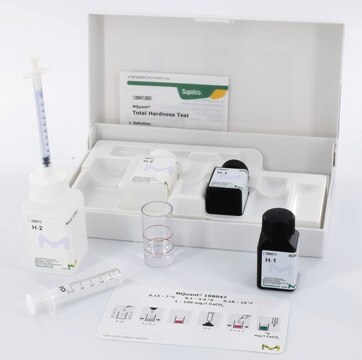1.00546
meta-Phosphoric acid
pieces for analysis (stabilized with sodium metaphosphate) EMSURE®
Synonym(s):
Metaphosphoric acid, m-Phosphoric acid
About This Item
Recommended Products
vapor pressure
<0.001 hPa ( 20 °C)
Quality Level
product line
EMSURE®
form
solid
composition
HPO<SUB>3</SUB>, 40-50% acidimetric
NaPO<SUB>3</SUB>, 50-60% acidimetric
impurities
≤1 ppm As (Arsenic)
≤10 ppm Cd (Cadmium)
≤10 ppm Chloride (Cl)
≤10 ppm Cu (Copper)
≤10 ppm Ni (Nickel)
≤10 ppm Pb (Lead)
≤10 ppm Zn (Zinc)
≤100 ppm Reducing matter (as H3PO3)
≤5 ppm Co (Cobalt)
≤5 ppm Mn (Manganese)
≤5 ppm Nitrate (NO3)
≤50 ppm Fe (Iron)
pH
2 (20 °C, 33 g/L in H2O)
bp
600 °C/1013 hPa
mp
200-250 °C
density
2.0 g/cm3 at 20 °C
bulk density
1000 kg/m3
storage temp.
2-30°C
Application
- Impact of pH and application time of meta-phosphoric acid on resin-enamel and resin-dentin bonding.: This study examines the effects of varying pH levels and application durations of meta-phosphoric acid on the bonding properties between resin and dental tissues. Meta-phosphoric acid demonstrates varying efficacy in enhancing adhesive characteristics, crucial for dental restorations (Cardenas AFM et al., 2018).
- Dicalcium phosphate (CaHPO4·2H2O) precipitation through ortho- or meta-phosphoric acid-etching: effects on the durability and nanoleakage/ultra-morphology of resin-dentine interfaces.: This publication explores how ortho- and meta-phosphoric acid etching influences the precipitation of dicalcium phosphate in dental applications, particularly focusing on its impact on the durability of resin-dentine interfaces and potential implications for dental repair longevity (Feitosa VP et al., 2013).
- Simultaneous determination of ascorbic acid, aminothiols, and methionine in biological matrices using ion-pairing RP-HPLC coupled with electrochemical detector.: This study details a method leveraging reverse-phase high-performance liquid chromatography to analyze ascorbic acid alongside other compounds, with meta-phosphoric acid used to stabilize the samples during the analytical process, highlighting its application in precise biochemical measurements (Khan MI et al., 2011).
- Extraction, chemical characterization and biological activity determination of broccoli health promoting compounds.: This research utilized meta-phosphoric acid in the extraction processes for analyzing the chemical properties and biological activities of health-promoting compounds in broccoli, demonstrating the acid′s utility in food science and nutritional analysis (Ares AM et al., 2013).
Analysis Note
Assay (acidimetric, NaPO₃): 50 - 60 %
Identity: passes test
Chloride (Cl): ≤ 10 ppm
Nitrate (NO₃): ≤ 5 ppm
Reducing matter (as H₃PO₃): ≤ 100 ppm
As (Arsenic): ≤ 1 ppm
Cd (Cadmium): ≤ 10 ppm
Co (Cobalt): ≤ 5 ppm
Cu (Copper): ≤ 10 ppm
Fe (Iron): ≤ 50 ppm
Mn (Manganese): ≤ 5 ppm
Ni (Nickel): ≤ 10 ppm
Pb (Lead): ≤ 10 ppm
Zn (Zinc): ≤ 10 ppm
Legal Information
Signal Word
Danger
Hazard Statements
Precautionary Statements
Hazard Classifications
Eye Dam. 1 - Skin Corr. 1
Storage Class Code
8B - Non-combustible, corrosive hazardous materials
WGK
WGK 3
Flash Point(F)
Not applicable
Flash Point(C)
Not applicable
Certificates of Analysis (COA)
Search for Certificates of Analysis (COA) by entering the products Lot/Batch Number. Lot and Batch Numbers can be found on a product’s label following the words ‘Lot’ or ‘Batch’.
Already Own This Product?
Find documentation for the products that you have recently purchased in the Document Library.
Protocols
Ascorbic acid in fruit juices - photometric determination with Tillmann's reagent
Our team of scientists has experience in all areas of research including Life Science, Material Science, Chemical Synthesis, Chromatography, Analytical and many others.
Contact Technical Service






